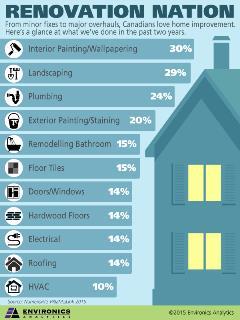Renovation Nation
It’s that time of year when lofty New Year’s Resolutions to curb our diets and save money begin to lose their luster. Rather than grapple with the endless self-improvement battle, many of us shift our focus to the four walls around us, which coincidentally look like they may need a coat of paint. Mid-winter is the perfect time to plan for home renovation projects—from painting a bedroom and replacing the old den flooring to embarking on a full kitchen make-over. According to Environics Analytics’ 2014 Numeris RTS PRIZMc2Link, 70 percent of Canadians own their home and, as it’s typically their most significant asset, they want to improve its value. In fact, in the past two years, 30 percent of Canadian households have painted the inside of their house or made improvements to their yards. But like the promise of eating only one potato chip, starting with just one project can blossom into multiple renovations, so it’s no surprise that nearly 15 percent of households laid hardwood or laminate flooring and an equivalent number remodeled their tired-looking bathroom into the powder room they always wanted.
 Click to enlarge
Click to enlargeEven those who are comfortable with their humble abode can be inspired by the images of white-washed kitchens and high-tech appliances found in décor publications like Canadian House and Home. And research shows that nearly twenty percent of Canadians tune into Home and Garden Television (HGTV) for programs on renovation tips and real estate flips. Magazines, TV programs and home make-over blogs often show the project in the before-and-after dream-home stages, but there are more renovation disaster stories than there are nails in a backyard deck. And those who have survived a renovation know that it can break a budget and tax even the most highly-skilled handyman. Despite the challenges that accompany a renovation, Canadians still proceed with efforts to make their surroundings more comfortable for their lifestyle and lifestage. That’s why different types of people are more likely to add a room, fix up the kitchen or repair a fence that the raccoons knocked down.
According to our PRIZMc2 segmentation system, households which are likely to add an extra living space to their home are found in segments like Ville Tranquilles (middle-aged francophone families and couples), Tools & Trucks (upper-middle-class town families and couples) and New Homesteaders (rural, midscale couples and families). They’re typically empty- or nearly-empty-nesters with traditional family values and home-centred lifestyles. Their exurban and rural properties are large enough to add a basement suite, in case the in-laws arrive for an extended stay, or build a sunroom off the kitchen to take advantage of the daylight.
On the other hand, upper-middle-class couples climbing the corporate ladder may want to make their homes reflect their wannabe upscale status. Members of segments like Mr. & Mrs. Manager (upscale, dual-income exurban households), La Vie est Belle (upper-middle-class, suburban Quebec families) and Suburban Gentry (wealthy, middle-aged suburban families) are likely to take on a large project like renovating a bathroom or over-hauling a kitchen. These types of projects often involve moving walls and plumbing, replacing appliances and upgrading electrical wiring—and they can be costly. But households like these have the income to afford the materials and labour required to transform the kitchen into a culinary Shangri-la.
Most homeowners with yards do some maintenance or landscaping. But the PRIZM segments where mature couples and families live tend to score high for doing outdoor projects like repairing decks and fences. Members of Golden Ponds (downscale small-town seniors), Les Traditionnelles (midscale, Québec town families and couples) and Nearly Empty Nests (older suburban couples and families) all tend to be older, live outside the city or in smaller communities, enjoy the outdoors and typically have more time to spend relaxing in their backyard. And many seniors and older couples have already been through a renovation and are well aware of the effort and expense of living in their home during the process, so a backyard project is less intimidating. Older Canadians may not feel pressured to keep up with the Jones, so renovating the kitchen with the latest fixtures may not seem as important as it once did.
Home improvement, like chocolate, can be addictive—and moreso at different stages of life. The investment we put into our home is often a financial one. But it’s also an investment in ourselves. Our home is where we hang our hat, and hang out, so we make it as comfortable as we can. And once the excitement, stress and inconvenience of a renovation is over, we may just want to sit back, sip a glass of wine in our new kitchen and think, well, maybe it’s time to move.
—Nicole Wright


